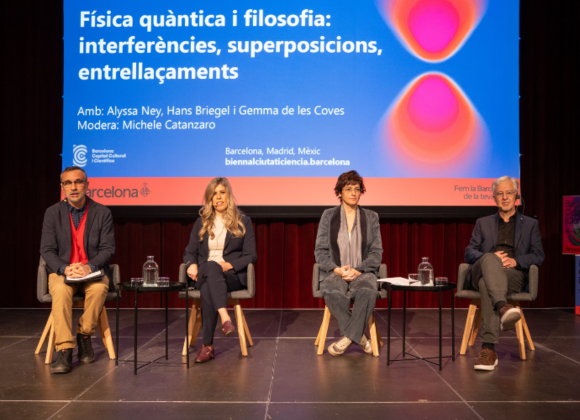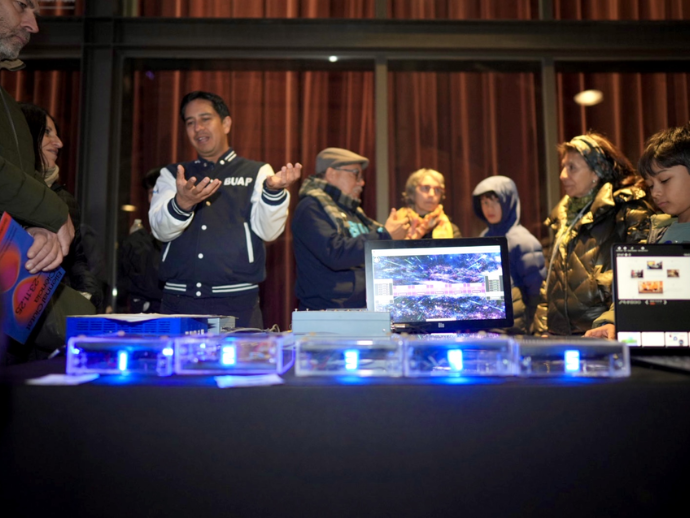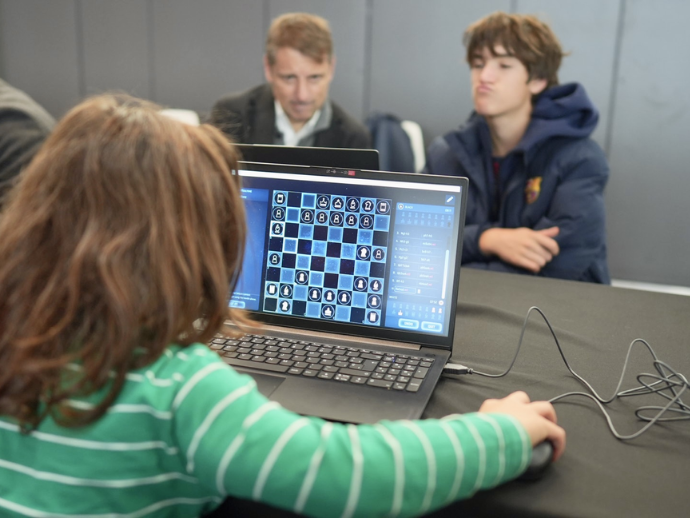The City and Sience Biennial closes with record participation figures
The 4th edition of the Biennial City and Science 2025 closed its doors yesterday, Sunday, in both Barcelona and Madrid, after six days of intense programming. Focused on quantum physics, the event included free activities of all kinds: workshops, conferences, artistic installations, or film cycles designed to bring science and frontier research closer to citizens, and generate curiosity, questions and vocations.
In total, up to 20.000 attendees have passed through the Biennial's facilities. Of this figure, 17.500 correspond to Barcelona (where there were 4.500 registered for workshops and conferences and 13.000 visitors to the artistic installations in El Born and to the Science Night on Saturday evening). In Madrid, on the other hand, 2.300 people attended.
The Deputy Mayor for Economy, Housing, Finance and Tourism, and head of the science area, Jordi Valls, has expressed that the Biennial is an example of how Barcelona is committed to research and the dissemination of science at a time when “the great geopolitical battle of our time is no longer played out only between states, but between large technological corporations that concentrate unprecedented power in areas such as artificial intelligence, quantum computing or digital security. The risk is not the technology, but the use we make of it. The future cannot be left in the hands of a new technological authoritarianism.”
Valls, on the other hand, assured that “Europe needs to strengthen its scientific capacity - and especially quantum - to guarantee technological sovereignty and protect democratic values. And Barcelona is already contributing to this with projects such as the MareNostrum supercomputer, the Quantum Communications Ring and a leading research and innovation ecosystem on the continent. We want the most advanced technologies at the service of a freer, fairer and more sustainable society. This is our commitment.”
Most relevant events
More than 70 experts have participated in this Biennial, including internationally renowned names such as Juan Ignacio Cirac, Carlo Rovelli, José Ignacio Latorre, Chris Ferrie, Olaya-Castro and Philip Ball, the brand new winner of the 7th edition of the Nat Prize organised by the Barcelona Museum of Natural Sciences and who kicked off the event on Tuesday with the award ceremony at the Hivernacle in Ciutadella Park.
Among the most successful conferences with spectators are those given by José Ignacio Latorre and Juan Ignacio Cirac on Wednesday and Friday, respectively, which sold out. The Science Night, on the other hand, was also very well received, with activities such as the demonstration of El Piano Còsmic, the monologue show by Big Van Ciencia or the session on electricity and quantum computers by Dorkbot Barcelona.
Another event that has aroused the most interest has been the experiments and games, and also the round tables, especially those on geopolitics and philosophy, the latter led by Alyssa Ney, or the one that has debated the role of women in science and which has had the presence of scientists such as Dafna Feinholz, María Josefa Yzuel and Núria Castell. In both these cases, as in the rest of the dialogues and conferences, the public has been very participatory during the question and answer period.
In addition to the central programming in El Born, interested people have also been able to enjoy activities of all kinds in other spaces such as the civic center of the Convent of Sant Agustí, the Convent of Barcelona Activa, the Canòdrom, the Cinema Maldà or the Pompeu Fabra University, as well as events organized in other municipal facilities and included in the + Biennial program.
In Madrid, the opening ceremony was also worth highlighting, where an avatar of Albert Einstein participated in a conversation with María García Díaz and Carlos Sabín. This proposal was made possible thanks to the technology developed by the Q-Math research group of the Institute of Mathematical Sciences (ICMAT) and the Carlos III University. Juan Ignacio Cirac, for his part, also participated in a conversation with Marta Peirano in Madrid entitled “What is quantum optics?”. Carlo Rovelli’s conference with Blanca Pujals, also called “Quantum loops between Madrid and Barcelona”, aroused considerable interest.
FIL Guadalajara
One of the new features of this year's program is the extension of the Biennial to Mexico, within the framework of the Guadalajara International Book Fair, which will take place between November 29 and December 7. Taking advantage of Barcelona being the guest of honor, the FIL Ciencia has been scheduled, a space designed to bring scientific knowledge closer to everyone and awaken vocations among younger people. This extension of the Biennial will feature the participation of prominent voices from the scientific ecosystem who will share their reflections on the great contemporary challenges.
The FIL Guadalajara is a meeting point for the Spanish-language cultural industry, the most prominent cultural event in Ibero-America and a world reference. In addition to the scientific program, Barcelona will deploy an intense program of activities that will help show the city's potential in many different areas.
City and Science Biennial
The City and Science Biennial is one of the most important scientific culture events held in the city of Barcelona and a clear example of the commitment made by the city council to promote scientific research and dissemination. In fact, it is one of the outstanding actions of the Strategic Plan for Science and Innovation 2024-2027, which focuses on the transfer of knowledge as a driver of progress in society and the economy.
Quantum, in addition, is a strategic sector for Barcelona, as established in the science plan but also in the objectives of the Barcelona Innovation Coast. This is demonstrated by the fact that in the city and its surroundings there are prominent institutions in research in this field, such as the Barcelona Supercomputing Center (BSC), the ALBA Synchrotron or the Institute of Photonic Sciences.





